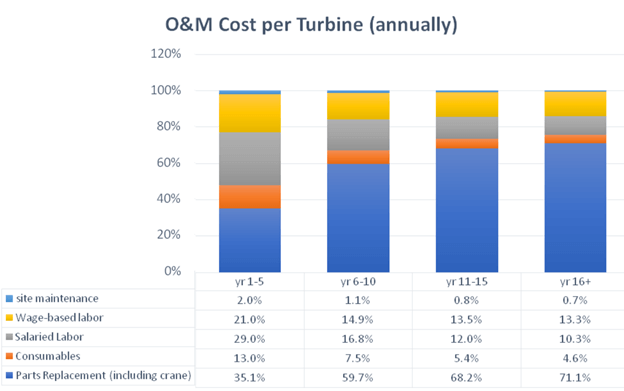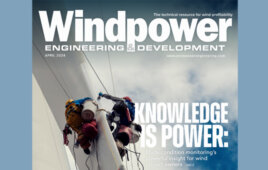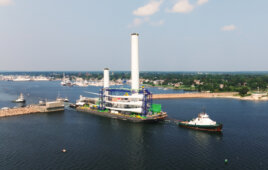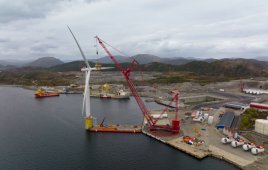By Gerrit van Doornik, President of Wind Solutions, Clean Energy Services
Ever since its invention to lift water for irrigation 5,000 years ago in Mesopotamia, the crane has been essential for lifting and moving heavy loads. The Roman empire added treadwheels so a single person could lift thousands of pounds. The first hydraulic-powered crane dates back to 1838. Now a wide variety of cranes allow many of the things we take for granted in a modern society — the type depends on the weight being lifted, the height it needs to be lifted to, and how long the crane will remain in place.
Fixed tower cranes allow the construction of immense skyscrapers. Robotic industrial cranes move products and equipment during manufacturing processes. Horizontal gantry cranes lift and lay sections of bridges and overpasses on highways and load and unload massive container ships at ports.
In wind energy, several styles of mobile cranes are used, including crawler cranes, all-terrain truck-mounted cranes and even floating cranes for offshore installations. Recently, purpose-built wind turbine assembly cranes have begun to enter the market, hoisting themselves to the top of wind towers and then lifting the turbine components into place.
As turbines proliferate and towers grow to sky-scraping heights, cranes will continue to play an essential role in our clean energy future. Crane equipment and labor costs make up anywhere from 30 to 50% of the cost of turbine maintenance. Further innovations in positioning and scheduling these cranes, and in training the required labor force, can help control these costs.
Two of the primary costs of crane operation are transportation and downtime. Cranes can be as large as the towers they erect and, depending on the type, must be dismantled for transportation from site to site. A single day’s rental can cost anywhere from $10,000 to $50,000, depending on the size required.
Transporting a crane to the site typically requires 20 or more truckloads. Each truck can move a load about 600 miles a day, or multiple loads over a shorter distance. If a crane needs to move 100 miles, it would likely need a truck to move two to three loads in a day. Mobilization cost can be almost 50% of overall crane cost for a single turbine repair.
Economies of scale and careful planning can help to solve this problem. Say a turbine needs major maintenance every five years, on average, and the maintenance cycle lasts one week. If used efficiently, a single crane could theoretically maintain 52 turbines per year, or 260 turbines over five years. When large numbers of turbines — 150 to 200+ — are located close together, a crane can be dedicated full-time to that site, cutting down dramatically on relocation costs.
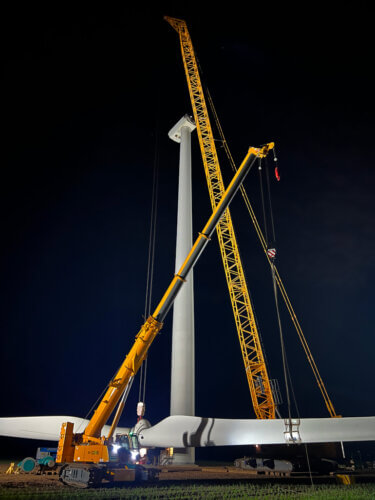 On-site labor downtime can add up as well. Once the crane is delivered, it takes a few days to set it up, depending on crane type. When maintenance tasks are completed, it takes another couple days to dismantle and prepare for loading onto trucks to start the process again.
On-site labor downtime can add up as well. Once the crane is delivered, it takes a few days to set it up, depending on crane type. When maintenance tasks are completed, it takes another couple days to dismantle and prepare for loading onto trucks to start the process again.
The crane team and turbine technician team work on different scopes. Whenever the crane is being assembled, moved or disassembled, the tech team is idle and more crane personnel are needed. Once the crane is ready to work, the technicians are working but fewer people are needed on the crane side. This leads to inefficiencies on both teams; up to 40% of labor costs can come from idle time.
Cross-training technicians to be proficient in both crane operation and wind turbine maintenance can be an effective way to reduce costs and improve the efficiency of the entire process. By eliminating the need for separate technicians for each task, companies can save significantly on recruiting and reduce the number of personnel on site.
In addition to the direct savings, cross-training can also improve the overall efficiency of the maintenance process. Having technicians familiar with both cranes and wind turbine communication and coordination can streamline the work and further reduce downtime. And for the wind turbine owner, this makes the process far easier, as a single contractor can complete each element of the turbine maintenance process.
However, cross-training technicians can be a significant undertaking, as it requires time and resources to provide the necessary education and ensure that technicians are proficient in both areas. Investments in additional equipment and training materials may be needed. Clean Energy Services has achieved this in the short term by developing an in-house cross-training program. For the longer term, CES has partnered with Houston Community College to develop courses in crane operations and turbine maintenance, ensuring a consistent pipeline of skilled labor.
Despite these challenges, the cost savings and efficiency improvements make cross-training crane teams a potentially worthwhile investment for companies involved in wind turbine maintenance, on top of the savings to be found for the cranes themselves.
 Gerrit van Doornik is President, Wind Solutions, for Clean Energy Services, founded in 2021 as “a reliable, tech-savvy provider of renewable energy services to large, blue-chip clients as well as smaller upstarts.”
Gerrit van Doornik is President, Wind Solutions, for Clean Energy Services, founded in 2021 as “a reliable, tech-savvy provider of renewable energy services to large, blue-chip clients as well as smaller upstarts.”
Filed Under: Featured

